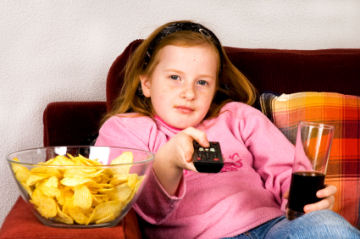Recipe for health
Obesity is on the rise, but there are plenty of things you can do to maintain a healthy weight.
By Emily Sohn
Everybody wants to be healthy, but today’s world is full of roadblocks. You know you should eat broccoli, for example, but it’s a lot easier to buy French fries (and they taste better). You know you should exercise, but your friends are playing video games.
For many people, the temptation to indulge is irresistible. But all of that indulging is catching up with us.
 |
|
Junk food, like chips, candy, and cookies, are easy to snack on—and often yummy. But they can pile on the calories and lead kids to become overweight. |
| iStockphoto |
In the United States, two out of three adults now weigh more than they should, according to the Centers for Disease Control and Prevention (CDC). More than 30 percent of Americans over 20 have so much body fat that they’re considered obese. Only half as many adults were obese in the 1980s.
Young people are also getting way too heavy. The proportion of overweight kids between the ages of 6 and 11 more than doubled in the past 2 decades, according to CDC data, from 7 percent to nearly 19 percent. Over the same period, the proportion of overweight teens more than tripled, from 5 percent to 17 percent. Healthy body weight is evaluated in terms of a number known as your body mass index, or BMI. You can check out whether you or a family member is overweight by plugging some numbers into a calculator at an online site (see sidebar: “Understanding Body Mass Index”).
These statistics are alarming because weighing too much increases the risk for heart disease, diabetes, cancer, sleeping troubles, and other health problems (see “Packing Fat”). People form lifelong eating habits when they’re still kids. And studies show that overweight children tend to become overweight adults. Indeed, some kids are already developing weight-related diseases such as type 2 diabetes, which used to show up only in adults.
“Children are primed to learn about eating,” says Susan Johnson, a pediatric nutritionist at the University of Colorado-Denver School of Medicine. “We need to start young with healthy habits.”
And it’s not as hard as you may think. Research shows there are plenty of simple things you can do to eat better, control your weight, and improve your health, even while you’re still a kid.
How do you start? Focus on three things: when, what, and how much.
The ‘when’
There’s no single explanation for why kids’ waistlines have been expanding, according to experts. The problem is more complicated than that.
For one thing, food is everywhere, almost all the time: from candy in school vending machines to popcorn at the movies. Fast-food restaurants are convenient and cheap. All too often, one meal runs into the next.
“It is practically impossible to avoid opportunities to eat,” Johnson says. “I’m only 49, but when I was a child, people did not eat all day long.”
Johnson, who studies eating behaviors, recommends eating three solid meals every day, and adding no more than two or three snacks to that total. Keep in mind, she says, that snacks include not only solid foods but also beverages such as juice and soft drinks.
Eating should be part of your daily routine, she says, just like brushing your teeth, practicing an instrument, or doing homework. For eating, just as for each of these other activities, there should be a definite time to begin and end.
 |
|
Choosing when to eat should become a routine, like brushing your teeth. Even a burger between meals can be bad for the waistline. And a burger alone—even at meal time—does not offer the proper balance of nutrients you need. |
| iStockphoto |
That routine should start with breakfast, suggests a recent study by researchers from the University of Minnesota School of Public Health. For a large number of kids, it doesn’t. Between one in four and one in eight children and teenagers regularly skip the first meal of the day, these researchers estimate. Previous studies have linked skipping breakfast to poorer grades—possibly, in part, because it’s hard to think well when you’re low on energy.
To investigate the effects of breakfast on weight, the Minnesota researchers followed 2,200 adolescents for 5 years. At the end of their study, they found that kids who ate breakfast tended to gain the least weight. Breakfast diners also tended to eat healthier foods and to exercise more than kids who skipped breakfast.
Scientists haven’t proved that eating breakfast causes people to stay slimmer. But starting the day with a bowl of cereal or eggs and toast is clearly linked to better health.
Studies suggest that if you skip breakfast, Johnson says, “you more than make up for it in the later part of the day.”
What you eat matters as much as when you eat. You probably know that an apple is more nutritious than a cookie. But supposedly healthy foods, such as granola bars and yogurt, can also lead to weight gain if you don’t pay attention to how much sugar they contain.
Sugar is full of calories. We need the energy those calories provide to fuel our activities and the bodily processes that keep us healthy. But our bodies turn excess calories into body fat.
Reading nutrition labels can help you find the right balance. Try not to eat too many foods that list sugar or corn syrup (a sweetener) as one of the first ingredients. And watch out for high carbohydrate counts (see sidebar: “Understanding Major Nutrients”).
You might also want to cut down on potato chips and other salty snacks. In 1997, researchers recorded everything 2,000 kids ate and drank for a solid week. All the participants were between 4 and 18 years old at the time of the study. Recently, scientists from St. George’s University in London analyzed records from that study.
The researchers found that kids who ate more salt also drank more soft drinks, which are full of sugar but empty of nutrition. One behavior doesn’t necessarily cause the other. But by eating fewer salty foods, the researchers concluded, kids might be able to cut out lots of unnecessary—and potentially fattening—calories.
 |
|
Food is everywhere, but the smart thing to do is snack on items that offer vitamins and fiber—like this apple—not just sugar, like cupcakes, or salty and fatty foods, like French fries. |
| iStockphoto |
Thinking too much about ice cream, onion rings, and all the other things you shouldn’t eat is a sure way to fuel cravings for those foods, according to researcher Brian Wansink, who is executive director of the U.S. Department of Agriculture’s Center for Nutrition Policy and Promotion.
Focusing instead on what you can have is a better strategy, he says in his book Mindless Eating: Why We Eat More than We Think. Wansink encourages kids to have one fruit and one vegetable with every meal.
You can fit in only so much food at one sitting, he says. Adding healthy foods to your plate can keep you from filling up on the unhealthy stuff.
One of the best ways to avoid eating junk food, Wansink adds, is to stop keeping it in your house. That’s something you might want to tell the adults you live with: Studies show that the person who buys and prepares food for a household controls 73 percent of what the family eats.
The ‘how much’
Determining how much you need is the final piece of the eating-well puzzle. This is often easier said than done.
 |
|
Eating well means stopping when you’re no longer hungry, and including a fruit and vegetable with every meal—even when you’re out picnicking. |
| iStockphoto |
In a study published this year, Wansink and his colleagues asked more than 250 people how they decided when to stop eating at mealtime. Thinner people tended to stop when they were full. Heavier ones, however, said they generally stopped when they’d eaten everything on their plates.
That can be a big problem, Wansink notes, because we’re often served far more food than we need—at home and in restaurants. And overeating can start early. In one study, 5-year olds ate 26 percent more food when they were given bigger servings.
Wansink has turned up similar results with grown-ups. He took a group of adults who had just finished a meal and offered to let them watch a movie. Popcorn was offered to everyone during the movie. It wasn’t good popcorn—in fact, it was stale. Nevertheless, people ate 53 percent more popcorn when given a large bucket instead of a medium–size one. In other studies, he found that people served themselves more food and went on to eat more food when they were given larger plates or bowls.
Using smaller dishes is an easy way to prevent mindless overeating. So is turning off the television. Not only does watching TV automatically make many people want to start chowing down, Wansink says, but it also distracts them from paying attention to how much they’ve eaten.
The average person makes more than 200 decisions about food every day, according to Wansink’s research. With a little thought and planning, you can make those decisions smart ones.
People who are overweight carry around excess body fat. When that bonus fat reaches a really unhealthy level, we say that a person is obese. We generally call obese people fat.
So how do you know who’s pudgy—as in somewhat overweight—and who is fat? Where is the dividing line?
Researchers answer that question using a mathematical calculation. The resulting number is known as body mass index, or BMI. BMI is a fairly reliable indicator of body fatness. That’s why scientists use it to screen for people who may be at risk of weight-related health problems. To figure out BMI, you must know precisely someone’s weight and height.
Want to calculate your BMI? The Centers for Disease Control and Prevention (CDC) has a Web site for this purpose. You can plug in some numbers and figure out your BMI. It’s at this site.
But what BMI is healthy, and which number indicates someone is overweight?
There’s no quick answer here. That’s because healthy boys and girls tend to have different amounts of body fat. The BMI calculation must account for that. Also, how much body fat is healthy depends on your age—at least from the time you’re a toddler to a young adult.
Here again, CDC can help out. One of its Web sites has tables and graphs to indicate what the BMI should be for males and females of all ages. To see the table, go to their Web site.—Janet Raloff
Adults frequently refer to apples, fish, broccoli, and lean chicken as “nutritious.” Brownies, soda pop, ice cream sundaes, and French fries, meanwhile, are often labeled “junk foods.”
What makes one group of foods good and the other bad? The answer lies mostly in the share of their energy—known as calories—that comes from particular sources.
Everything in food doesn’t have calories. For instance, most fiber doesn’t. Vitamins are caloriefree, as are minerals, natural coloring chemicals, salt, and most natural flavorings. In fact, the only things that do have calories are carbohydrates, fats, proteins, and alcohol. That list may look short, but with the exception of water, these four nutrients account for most of what’s in food and beverages—at least by weight.
Carbohydrates, often called carbs, include sugars and starches. Each gram of carbs puts 4 calories into a food. It doesn’t matter if the carb is table sugar or the starch in a potato—a gram of each provides the same amount of energy. The main function of carbohydrates, especially sugars, is the quick release of energy. That energy fuels a host of bodily processes, including those that allow you to run and grow. Starches tend to be more complicated molecules, made by combining sugars and other materials. They break down more slowly than sugars, so they release their energy more slowly.
Proteins, made from combinations of building blocks known as amino acids, give energy. They also help build body tissues, such as muscle. Each gram of protein contributes 4 calories.
Fats are energy dense. A gram of fat delivers more than twice as much energy—9 calories in all—as does an equal weight of carbs or protein. Although fats tend to get a bad name, they are very important. The body uses fats as building blocks to help make the walls of cells throughout the body. Many fats also turn on different processes and signals.
Fats work in different ways. Some turn on signals that encourage the body to store them as body fat; others do just the opposite. Eating some types, such as saturated and trans fats, has been linked with an increased risk of heart disease. But other types, such as those known and omega-3’s, have been linked with heart health. So it’s too simple to just say fats are bad—or good. It all depends on the type and the amounts.
Alcohol is not something kids should have to worry about, since it’s illegal for Americans under 21 to drink it. However, it does show up in some foods and in medicines, such as many cough syrups not targeted at children. However, every gram consumed brings another 7 calories into the body.
When a large share of a food is made from fats or sugars, they tend to acquire a bad rep—they’re labeled junk foods. The reason: They give us energy but few other important micronutrients—such as vitamins. Or they encourage us to overeat.
That’s a special problem with fats and sugars, because our tongues have special receptors for both. It seems to be Mother Nature’s way of encouraging us to eat sugars and fats when they’re available.
And that was a good strategy when people lived in clans of roaming hunter-gatherers several thousand years ago. Food was hard to come by, so the body encouraged us to eat foods rich in calories. Now that food is plentiful, easy to find, and inexpensive, our bodies may encourage us to eat much more than we need.
The important thing to keep in mind is that neither carbs nor proteins nor fats are necessarily bad. The problem comes when we overeat—or undereat—any of them.—Janet Raloff
Going Deeper:







